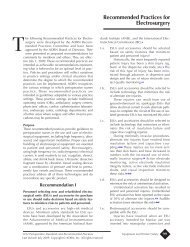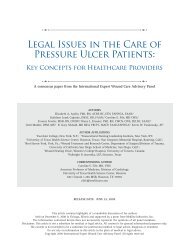For all comparisons, we considered <strong>CAUTI</strong> outcomes as well as other outcomes critical toweighing the risks <strong>and</strong> benefits of different catheter management techniques. The evidence <strong>for</strong>this question consists of 6 systematic reviews, 37,105,106,182-184 56 RCTs, 60,61,65-69,143,158,158,185-231 34observational studies, 83,85,88,90,96,102,133,167,178,232-258 <strong>and</strong> 1 economic analysis. 180 The findings of theevidence review <strong>and</strong> the grades <strong>for</strong> all important outcomes are shown in Evidence ReviewTable 2C.Q2C.1. Antimicrobial prophylaxisLow-quality evidence suggested no benefit of antimicrobial prophylaxis in patients undergoingshort-term catheterization. 37,60,61,83,85,133,158,178,182,185,186,189-191,232-234 This was based onheterogeneous results <strong>for</strong> SUTI <strong>and</strong> bacteriuria/unspecified UTI <strong>and</strong> no adverse events relatedto antimicrobials. Lack of consistency in specific factors, such as patient population,antimicrobial agents, timing of administration, <strong>and</strong> duration of follow-up, did not allow <strong>for</strong> asummary of evidence of the effect of antimicrobial prophylaxis on <strong>CAUTI</strong> in patients undergoingshort term catheterization. Only two studies evaluated adverse events related to antimicrobials.Our search did not reveal data on antimicrobial resistance or Clostridium difficile infection.Low-quality evidence suggested no benefit of antimicrobial prophylaxis in patients undergoinglong-term catheterization (indwelling <strong>and</strong> clean intermittent catheterization). 106,183,192,194,235,238This was based on a decreased risk of bacteriuria, heterogeneous results <strong>for</strong> SUTI, <strong>and</strong> nodifferences reported <strong>for</strong> catheter encrustation or adverse events, although data were sparse.One systematic review suggested an increase in antimicrobial resistance with antimicrobial use.Q2C.2. Urinary antisepticsLow-quality evidence suggested a benefit of methenamine <strong>for</strong> short-term catheterizedpatients. 196,197 This was based on a reduced risk of SUTI <strong>and</strong> bacteriuria <strong>and</strong> no differences inadverse events. Evidence was limited to two studies of patients following gynecological surgeryin Norway <strong>and</strong> Sweden.Very low-quality evidence suggested a benefit of methanamine <strong>for</strong> long-term catheterizedpatients. 106,236-239 This was based on a reduced risk of encrustation but no differences in risk ofSUTI or bacteriuria. Data on encrustation was limited to one study. Studies involved primarilyelderly <strong>and</strong> spinal cord injury patients with chronic indwelling cathetersQ2C.3. Bladder irrigationLow-quality evidence suggested no benefit of bladder irrigation in patients with indwelling orintermittent catheters. 66,69,199-206,240-242 This was based on no differences in SUTI <strong>and</strong>heterogeneous findings <strong>for</strong> bacteriuria.Q2C.4. Antiseptic instillation in the drainage bagLow-quality evidence suggested no benefit of antiseptic instillation in urinary drainagebags. 90,207-211,243-245 This was based on no differences in SUTI <strong>and</strong> heterogeneous results <strong>for</strong>bacteriuria.Q2C.5. Periurethral care42
Low-quality evidence suggested no benefit of antiseptic meatal cleaning regimens be<strong>for</strong>e orduring catheterization to prevent <strong>CAUTI</strong>. 65,67,68,88,158,212-216,246,247 This was based on no differencein the risk of bacteriuria in patients receiving periurethral care regimens compared to those notreceiving them. One study found a higher risk of bacteriuria with cleaning of the urethralmeatus-catheter junction (either twice daily application of povidine-iodine or once daily cleaningwith a non-antiseptic solution of green soap <strong>and</strong> water) in a subgroup of women with positivemeatal cultures <strong>and</strong> in patients not receiving antimicrobials. Periurethral cleaning withchlorhexidine be<strong>for</strong>e catheter insertion did not have an effect in two studies.Q2C.6. Routine catheter or bag changeLow-quality evidence suggested no benefit of routine catheter or drainage bag changes toprevent <strong>CAUTI</strong>. 102,217-219,248,249 This was based on no difference or an increased risk of SUTI <strong>and</strong>no difference in bacteriuria with routine compared to as-needed changes or with more frequentchanging intervals. One study in nursing home residents found no differences in SUTI withroutine monthly catheter changes compared to changing only <strong>for</strong> obstruction or infection, but thestudy was underpowered to detect a difference. Another study in home care patients found anincreased risk of SUTI when catheters were changed more frequently than monthly.Q2C.7. Catheter lubricantsVery low-quality evidence suggested a benefit of using lubricants <strong>for</strong> catheter insertion. 167,220-223,250-254 This was based on a decreased risk of SUTI <strong>and</strong> bacteriuria with the use of a prelubricatedcatheter compared to a catheter lubricated by the patient <strong>and</strong> a decreased risk ofbacteriuria with use of a lubricant versus no lubricant. Studies were heterogeneous both in theinterventions <strong>and</strong> outcomes studied. Several studies comparing antiseptic lubricants to nonantisepticlubricants found no significant differences.Q2C.8. Securing devicesLow-quality evidence suggested no benefit of using catheter securing devices to prevent<strong>CAUTI</strong>. 224 This was based on no significant difference in the risk of SUTI or meatal erosion. Theonly study in this category looked at one particular product.Q2C.9. Bacterial interferenceModerate-quality evidence suggested a benefit of using bacterial interference in catheterizedpatients. 225 In the one study evaluating this intervention, urinary colonization with a nonpathogenicEscherichia coli was associated with a decreased risk of SUTI in adults with spinalcord injury <strong>and</strong> a history of frequent <strong>CAUTI</strong>.Q2C.10. Catheter cleansingVery low-quality evidence suggested a benefit of wet versus dry storage procedures <strong>for</strong>catheters used in clean intermittent catheterization. 255 This was based on a decreased risk ofSUTI with a wet storage procedure in one study of spinal cord injury patients undergoing cleanintermittent catheterization compared to a dry storage procedure where the catheter was left toair dry after washing. In the wet procedure, the catheter was stored in a dilute povidone-iodinesolution after washing with soap <strong>and</strong> water.Q2C.11. Catheter removal strategies43
- Page 4 and 5: AcknowledgementHICPAC thanks the fo
- Page 6 and 7: AbbreviationsADLAPACHE IIASAASBBUNC
- Page 8 and 9: I. Executive SummaryThis guideline
- Page 10 and 11: II. Summary of RecommendationsTable
- Page 12 and 13: II. Proper Techniques for Urinary C
- Page 14 and 15: 1. If obstruction is anticipated, c
- Page 16 and 17: a. Procedure-specific guidelines fo
- Page 18 and 19: III. Implementation and AuditPriori
- Page 20 and 21: IV. Recommendations for Further Res
- Page 22 and 23: V. BackgroundUrinary tract infectio
- Page 24 and 25: acteriuria inevitably occurs over t
- Page 26 and 27: VII. MethodsThis guideline was base
- Page 28 and 29: Figure 2: Results of the Study Sele
- Page 30 and 31: After determining the GRADE of the
- Page 32 and 33: Category I recommendations are defi
- Page 34 and 35: VIII. Evidence ReviewQ1. Who should
- Page 36 and 37: Evidence Review Table 1B. What are
- Page 38 and 39: Very low-quality evidence suggested
- Page 40 and 41: Q2B.2. Hydrophilic catheters vs. st
- Page 44 and 45: a. Clamping vs. free drainage prior
- Page 46 and 47: studies. 3,25,260-276 The findings
- Page 48 and 49: 2D.5. Maintain unobstructed urine f
- Page 50 and 51: 15. Jain P, Parada JP, David A, Smi
- Page 52 and 53: 44. Chaudhuri P, Vengadasalam D. Ur
- Page 54 and 55: 71. Kelleher RE, Meeropol E, Parks
- Page 56 and 57: 101. Hirsh DD, Fainstein V, Musher
- Page 58 and 59: 132. Van Nagell, JR, Penny RM, Rodd
- Page 60 and 61: 163. Lai KK, Fontecchio SA, Lai KK,
- Page 62 and 63: 193. Waites KB, Canupp KC, Armstron
- Page 64 and 65: 222. Cohen A. A microbiological com
- Page 66 and 67: 253. Chavigny KH. The use of polymi
















